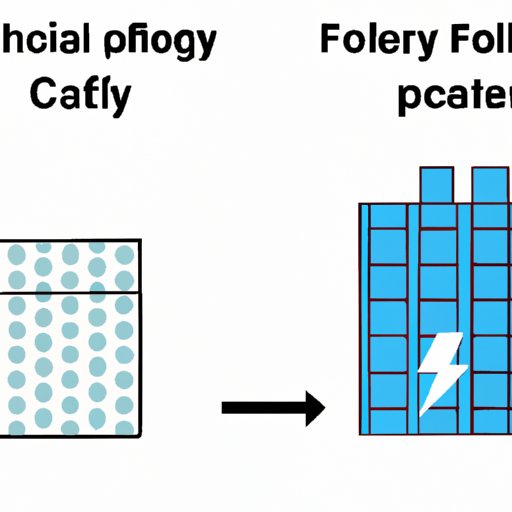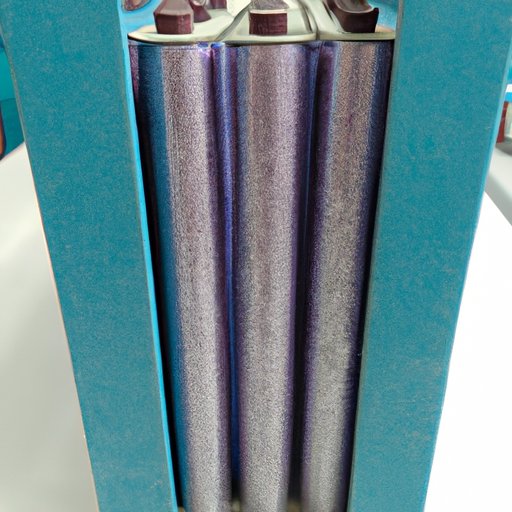Introduction
Fuel cells are electrochemical devices that convert chemical energy into electrical energy. They are an efficient way to generate electricity without producing pollutants or greenhouse gases. This makes them an attractive alternative to traditional energy sources such as coal and natural gas. But how do fuel cells actually work? In this article, we’ll dive into the details of fuel cell technology to answer this question.
Step-by-Step Guide to Understanding Fuel Cells
At its most basic level, a fuel cell is composed of two electrodes (an anode and a cathode) separated by an electrolyte. When the fuel cell is supplied with hydrogen fuel, it undergoes a reaction in which the hydrogen is broken down into protons and electrons. The protons pass through the electrolyte, while the electrons travel around an external circuit to create an electric current.
The chemistry behind this process is fairly complex. First, the hydrogen molecules enter the anode where they are split into positively charged protons and negatively charged electrons. The electrons then flow out of the anode, providing an electrical current, while the protons pass through the electrolyte. The protons then reach the cathode, where they combine with oxygen molecules to form water. This reaction produces heat, which can be used to power engines or generate electricity.
In addition to the anode, cathode, and electrolyte, there are several other components of a fuel cell that play a role in its operation. These include a membrane electrode assembly, a gas diffusion layer, and a catalyst. The membrane electrode assembly is responsible for the transfer of protons from the anode to the cathode. The gas diffusion layer helps ensure that the hydrogen and oxygen molecules are evenly distributed throughout the cell. Finally, the catalyst helps speed up the reaction, allowing the cell to produce more electricity.
Exploring the Basics of Fuel Cell Technology
Fuel cells come in many different types, each of which has its own advantages and disadvantages. The most common type is the proton exchange membrane (PEM) fuel cell, which is used in cars and other vehicles. Other types include direct methanol fuel cells, solid oxide fuel cells, and phosphoric acid fuel cells. Each type of fuel cell has its own unique characteristics, making them suitable for different applications.
One of the main advantages of fuel cells is their efficiency. Fuel cells produce electricity with much less waste than traditional energy sources, such as coal and natural gas. In fact, fuel cells can achieve efficiencies of up to 60%, compared to 30-40% for conventional energy sources. This makes them an attractive option for many applications.
Another advantage of fuel cells is their scalability. Fuel cells can be easily scaled up or down depending on the application, making them suitable for both small and large scale projects. Additionally, fuel cells can be used in remote areas where access to traditional energy sources is limited.

Comparison of Fuel Cells vs. Traditional Energy Sources
When comparing fuel cells to traditional energy sources, there are both pros and cons to consider. On the plus side, fuel cells are cleaner and more efficient than traditional sources. They also have a much lower environmental impact due to their lack of emissions. On the downside, fuel cells are generally more expensive than traditional sources, and they require a constant source of fuel such as hydrogen or methanol.
In terms of cost, fuel cells are still more expensive than traditional energy sources. However, the cost of fuel cells is continually decreasing as technology advances. Additionally, some governments offer incentives for using fuel cells, which can help offset the cost.
Conclusion
To recap, fuel cells are electrochemical devices that convert chemical energy into electrical energy. They consist of two electrodes, an electrolyte, and several other components which enable the reaction to take place. Fuel cells are more efficient and have a lower environmental impact than traditional energy sources, but they are still more expensive.
Overall, fuel cells are an important technology for the future of energy production. As technology advances and costs continue to decrease, fuel cells will become increasingly attractive as an alternative to traditional energy sources.
Resources
For more information on fuel cells, check out the following resources:
Websites: U.S. Department of Energy: What is a Fuel Cell?, Fuel Cell Today: About Fuel Cells
Books: Fuel Cell Fundamentals, by Ryan O’Hayre, Suk-Won Cha, Whitney Colella, and Fritz B. Prinz; Fuel Cell Technology Explained, by James Larminie and Andrew Dicks
(Note: Is this article not meeting your expectations? Do you have knowledge or insights to share? Unlock new opportunities and expand your reach by joining our authors team. Click Registration to join us and share your expertise with our readers.)
